The Blues Project and
Seatrain
Albums reviewed on this page: Live
at the Cafe A Go Go, Projections,
Live
at Town Hall, Planned Obsolescence,
The Moonstone,
Sea
Train, Seatrain, Marblehead
Messenger, Blues Project,
Watch.
The Blues Project is a group rarely mentioned these days, and
may
not have been that high-profile in the first place. Like the
Lovin' Spoonful and the Youngbloods, they started out on the East
Coast, the band had a good live reputation covering everything from
folk to R&B, but never found much success. Their one
semi-hit, "Flute Thing," was a bit out of character too,
relying on bassist Andy Kulberg showing off his classically-trained
flute skills. Odder still, they managed to record only one studio
album, Projections, before keyboardist Al Kooper's
desire to
add horns to the group caused them to split in 1967. Kooper
and
guitarist Steve Katz formed Blood,
Sweat and Tears, and the rest of the band re-located to the
West
Coast, to wait for guitarist Danny Kalb to join them. Kalb
never did, and so Kulberg put together a new band, beginning a long
partnership with lyricist Jim Roberts. After one album
released
under the Blues Project name, Planned Obsolescence,
the new
band became Sea Train, and successfully mixed just about everything
(blues, jazz, folk, bluegrass, classical). Their official
debut, Sea Train is one of the finest examples of
American
progressive rock, and the best place to start with the band.
Alas, it was unsuccessful commercially, and half the band left
afterwards. When Kulberg assembled Seatrain anew, they became
more of a standard roots-rock band, and focused greatly on the
talents of excellent violinist Richard Greene. A couple more
albums ensued (Seatrain and Marblehead
Messenger), and
one minor hit ("13 Questions") before the foundations
(Greene and guitarist Peter Rowan) dropped out again. Kulberg
made one final stab with the group (Watch) before
calling it a
day.
Still, those interested in progressive rock should check out Sea
Train, and roots-rock fans Seatrain.
The Blues Project: Danny Kalb (lead
guitar), Al Kooper
(organ), Steve Katz (guitar), Roy
Blumenfeld (drums),
Andy Kulberg (bass), Tommy Flanders
(vocals).
Flanders left before Live at the Cafe A Go
Go was
released. They broke up in 1967, with Seatrain really
recording
the final album Planned Obsolescence.
Reformed in 1971
with Blumenfeld, Kalb and Don
Kretmar (bass,
vocals) for Lazarus, and added David
Cohen (guitar,
keyboards) and Bill Lussenden (guitar) for their
final album
Blues Project.
Seatrain: Roy Blumenfeld (drums), Richard
Greene
(violin), John Gregory (guitar, vocals),
Andy Kulberg
(bass, flute), Don Kretmar (sax, bass), Jim
Roberts
(lyrics, vocals). By the second Seatrain,
Blumenfeld, Gregory and Kretmar
had left, to be
replaced by Larry Atamanuik (drums), Peter
Rowan (guitar,
vocals) and Lloyd Baskin (keyboards,
vocals). This
lasted for two albums, and on Watch, Atamanuik,
Greene and
Rowan are out, and Julio Coronado (drums)
in, along
with Bill Eliot (keyboards) and Peter
Walsh (lead
guitar). Then they split.
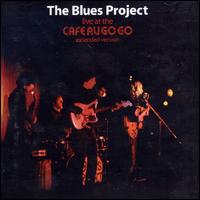 The
Blues Project: Live at the Cafe A Go Go (1966), **1/2
The
Blues Project: Live at the Cafe A Go Go (1966), **1/2
American
musicians influenced by English musicians, who were influenced by
American musicians. While it was perfectly acceptable for the
Yardbirds to release a live album of blues and R&B covers in
1964, by 1966 groups were expected to write their own
material.
Excepting one instrumental, "The Way My Baby Walks," this
album is just one standard after another. I mean, how many
covers of Willie Dixon's "Spoonful" does the world really
need? The band sounds like it was an outgrowth of the jugband
blues scene (the sing-along take on Willie Dixon's "You Go and
I'll Go With You"), along with The Lovin' Spoonful and the
Youngbloods.
Their material
consists exclusively of blues songs, and they shine when covering
some lesser-known material: an excellent cover of Eric Andersen's
dreamy folk "Violets of Dawn," and a beautiful, slow, jazzy
take on the traditional "Alberta." Guitarist Danny
Kalb was among the scene's best guitarists, eschewing the
Chicago-blues style for a jugband
band's dancing finger approach, but rest of
the band is
unexciting. Vocalist Tommy Flanders was decent, bassist Andy
Kulburg is sometimes inaudible and neither Steve Katz (who gets his
spotlight number on Donovan's lethargic ballad "Touch the Wind"
and is otherwise dispensable), nor Al Kooper (his spotlight is Chuck
Berry's "I Want to Be Your Driver") show much. An
interesting historical artifact, and pleasant enough to listen to
once in a while, but if you really want R&B and blues buy
yourself the Rolling Stones, the Paul Butterfield Blues band, or even
Willie Dixon himself. Produced by Jerry Schoenbaum.
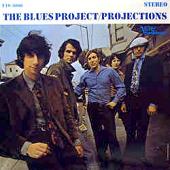 The
Blues Project: Projections (1966), ***
The
Blues Project: Projections (1966), ***
Despite
having a lot of things going for it - lots of talented musicians and
an closer ear to musical trends than most American bands - the Blues
Project never put it together. Sure, "Flute Thing"
was an underground hit, but this album is no underground
classic. R&B was still the band's main
element, and
they usually did a good job with it. Kooper's "I Can't
Keep From Crying" kicks off the album with a supremely catchy
bass riff, "Wake Me, Shake Me," and Chuck Berry's "You
Can't Catch Me" are all excellent tracks. Projections
is not all R&B of course, and the band experimented
with
classical folk (the intro to "Steve's Song" which is better
than actual song) and the infamous jazz-rock underground hit (an
oxymoron par excellence) of "Flute
Thing." The
latter is what both the album and the band are most remembered for -
but is it any good? It is an instrumental constructed around
a
nice lead riff, whichtakes advantage of the fact that Kulberg just
happened to be an excellent flautist, and so everyone takes turns
soloing. Well, everyone but Katz that is, but since he was
stuck playing bass, it is not a real loss. Not many
people were creating jazz-rock at this time, so it certainly was
ground-breaking, but nowadays it is just a nice song. The
same
can be said for other little contemporary cool moves, such as Kalb's
Indian-like guitar lines on "Cheryl's Going Home".
R&B may have been their bedrock, but Projections'
blues
numbers are its real drag. Kalb had his own easily
identifiable
technique, using quick runs with lots of note bending, but he mistook
plodding on indefinitely for drama (Muddy Waters' "Two Trains
Running" runs for over ten minutes and Jimmy Reed's "Caress
Me Babe" is a blues that is all atmosphere and no
excitement).
His speed also led him to get a bit sloppy in parts ("You Can't
Catch Me" among others). Still, he was clearly the
instrumental star - even though Kalb's bass lines are usually catchy,
and Kooper place-holds when given the chance to solo ("Caress Me
Babe"). Kooper displays the most songwriting talent, the
nice folk-rock "10" shows him merging his earlier pop
talent with Dylanesque folk-rock, and a touch of jazz. Sure,
Steve Katz has a song, but it is ...well, it's a Steve Katz
song.
Slightly goofy in nature, delivered in his earnest straight-man
voice, just like his cover of Bob Lind's folky "Cheryl's Going
Home". He never really hit his songwriting stride
until after the Project broke up. The result is an album that
has its moments and good songs ("I Can't Keep From Crying"
is my mark for a keeper), but feels like less than the sum of the
individual players.
Indeed,
this was their
only album that was entirely recorded in a studio. Afterwards
they split over a disagreement on whether or not to add horns, with
Kooper and Katz forming Blood,
Sweat and
Tears.
 Blues
Project at the Town Hall (1967), ***
Blues
Project at the Town Hall (1967), ***
Therefore
the sage manages affairs without doing anything.
-Lao Tze, Tao Te Ching, ch. 2, par. 3
Kooper
and Katz had
split, and the label, sensing trouble, released
this album to cash-in. Half is from an
undated concert at "the Town Hall" (wherever that is), with
some fill-in studio outtakes. Curious then that the album is
pretty good - the concert half really rocks and is pretty cutting
edge. Even rocks in a way that you would not expect from the
boys who put out Live at the Cafe A So-So. The
Project
were cranked up, fast, and blurred on the edges.
This
version of "Flute Thing" (titled "(Electric) Flute
Thing") takes the jazzy underpinnings of the original and runs
off into psychedelic territory. The band got so far out there
that Kooper played static on his organ, Katz made odd clunking
noises on the bass, while Kulberg played against a delayed
version of himself on flute. This was brand new for 1967, and
was the same thing that both Terry Riley would do with Poppy Nogood
and the Phantom Band, and more famously Brian May of Queen would do
with guitar. Pretty cool. Kalb was as fast and
sloppy as
ever ("I Can't Keep from Crying"), although he is sometimes
hard to hear in the mix. This version of "I Can't Keep
from Crying" is downright revelatory: it unlocks the mystery of
Steve Katz. It turns out good old Steve was a hardcore rhythm
guitar player, in addition to his passable harmonica skills.
I
mean, how many rhythm guitarists do more than just strum
away?
Katz made the rhythm guitar punch - bursts of electricity
pulsating along with the rest. After all that breakneck
playing, Kooper topped the song off with one of his odd ondioline
solos, sounding like the electric bagpipes (if such a thing
exists).
Sweaty. Great. The other two live tracks ("Mean Old
Southern" and a long version of "Wake Me, Shake Me")
are not as good, but they still show a band far more interesting than
Projections, as they get the little things right as
only a
band that has worked through the numbers can. "Wake Me,
Shake Me" has some nice moments of interplay between the
band.
Oddly enough, the thing that sounds most out of place is Kooper's
organ amongst the suped-up guitars. The ondioline is bizarre
enough that he sounds futuristic, but aside from that his solos are
never anything that make you go wow, a lot of times
he sounds
like the passable session guy who played on Dylan
albums.
The
studio tracks are
a letdown, comparatively - the necessary lukewarm Katz folk cover
("Love Will Endure"), and a couple of more poppy Kooper
numbers. His "No Time like the Right Time" has a
great mid-60s soul chorus, s uch that you could hear someone like Mitch
Ryder destroying with it, but the others are the sort of passable
fare that was wisely cut from Project records. It is pretty
strange that some of their best tracks came out without their even
really trying. The live tracks will not make anyone forget
about the MC5, but they show that the band really had
energy, often lost in the studio.
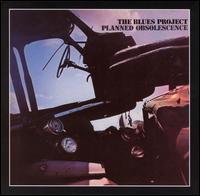 Blues
Project: Planned Obsolescence (1968), ***1/2
Blues
Project: Planned Obsolescence (1968), ***1/2
Somewhere
on the spectrum between contract filler and normal album lies Planned
Obsolescence. It is a shame that nobody
really
remembers this album, because it shows that America did make
progressive rock. The Blues Project started with an album
that showed their stylistic diversity (Live at the Cafe Au Go
Go),
and to live up to their name the group mixes the blues into the sound
in various ways. Planned
Obsolescence was really a group effort, and with violin
(Greene),
sax (Kretmar) and flute (Kulberg) at their disposal a great mix of
blues, jazz and folk was at play. This
incarnation can
deliver "Mojo Hannah," a fascinating kick-butt slice of
blues and soul, and then follow it up with "Niartaes Hornpipe"
a folky tune that incorporates some bluegrass from
Greene.
They generally stuck with the same jazz-blues vibe that contemporary
Jethro Tull used,
although without the
same drive or force ("She Raised Her Hand", "If You
Gotta Make a Fool of Somebody"). Yet, they also predict
where Jethro Tull was headed, playing traditional classical/folk
music in other spots ("Calypso, "Turtle Dove" a
traditional folk song arranged into a well-disguised blues
number).
Planned Obsolscence has a very loose feeling,
perhaps caused
the fact that this was a contract-fulfilling album. I do not
know how to explain Gregory's "Frank 'N' Curt: Incensed"
which is blues-rock with Dylan-esque lyrics, fuzz guitar and a decent
jazz line by Kretmar plopped in the middle, or Gregory's off-the-cuff
vocals during "Endless Sleep." Still, the "contract
fulfilling" flags are raised throughout. Only "Calypso,"
"She Raised Her Hand" and "Frank 'N' Curt: Incensed"
are songs written by the group. The first two bear the
hallmark
of Seatrain - poetic lyrics by Jim Roberts. Another flashing
light is the 10 minute traditional jazzy jam which closes out the
album ("Dakota Recollection"). Fear not - the core
band was a good live act with enough playing skills to pull it off.
"Dakota Recollection" was traditional in that everyone a
chance to step out and solo, before pulling back and supporting the
others. Nobody's going to mistake this for an English band,
although few rock bands were delving this far into jazz, outside of
Spirit or Soft Machine's Third.
Even though it was 1968, only a few inoffensive production tricks
appear (backwards music at the end of "Calypso" for
example) and one pretty bold one - having Kulberg play against a
delayed tape of himself ("Dakota Recollections"), like he
did live at the Town Hall. The final
warning flag is
that the album jacket credits the production and arranging to the
Blues Project, while the actual record gives it to Seatrain.
The arrangements aren't quite up to the level of Seatrain's official
debut, but are still good. It's a shame it did not sell -
maybe
it lacked the braying horns of their sister
group. Self-produced.
 Tommy Flanders: The Moonstone (1969), **1/2
Tommy Flanders: The Moonstone (1969), **1/2
The
few tracks from Live
at The Cae A Go Go provide
only a glimpse of Flanders as a fine blues singer. Afterwards
it
appears he picked up an acoustic guitar and fashioned himself into more
of a folk singer. His solo album is a low-key folk album,
with
tinges of country. Perhaps, the American
analogue of something from Joe Boyd, but nowhere quite as
good. Actually, it was self-produced, and it sounds like
Flanders
hired some help and recreated his solo act live in the studio, even
including some appropriate stage chatter. Flanders was
primarily
a singer, and his wisdom was in his choice of help: rhythm section and
two dancing guitars which provide the most musical interest.
At
best it sounds like a lower-grade Pentangle ("Blue Water Blue", "The
Moonstone") or with echoes of Dylan ("Purple and Blue") .
Vocally, he had a fine voice with one well-employed move - a
slow
jump to a hanging falsetto ("Age of Mercy"). But despite the
hands pitching in, Flanders' lyrics are banal words about nameless
girls ("By the Mailbox We Stood") and his songs often empty ("Boston
Girls"). I don't think it made much of an impact, and he was
part of the Blues Project reunion a few years later. The
backing
musicians are more interesting than the music itself: veteran folk
guitarists Bruce Langhorne (who had backed Dylan) and Dick
Rosmini, bassist Jerry Scheff was a big session man, and
drummer
Michael Botts was later in Bread. (Ugh, Bread).
Danny
Kalb & Stefan Grossman: Crosscurrents (1969)
Acoustic blues workout with the two guitarists. It has a good
reputation.
 Sea
Train (1969), ****1/2
Sea
Train (1969), ****1/2
This
gets my vote for America's best progressive rock album of the 60s,
hands down. This was certainly the year for it, coming out
alongside Chicago,
The
Flock, and Blood
Sweat &
Tears. But there are big differences
between those
albums and this one. First of all, looking across the ocean,
Seatrain's structure resembled Yes more than any other band.
There was no one stand-out member (a la Flock) or a section that was
clearly the focal point (i.e., Chicago and BS&T's
horns).
The sound has a great deal of give and take between everyone in the
band, making Sea Train a group effort similar to The
Yes Album. Another large difference
between Seatrain
and the aforementioned American bands is their lyrics.
Seatrain
had a dedicated lyricist, Jim Roberts, whose lyrics were by and far
more poetic than other bands', focusing on personal experience and
wispy romance. Making him, well, a very lyric lyricist,
usually paired either with Kulberg or Gregory in songwriting.
Gregory had a warm tenor voice, but not a pure one, and engaged in
what could be termed as "friendly, light shouting" when he
gets louder ("As I Lay Losing"). At the same time,
the band shied away from the long songs normally associated
with progressive music. Not that they lacked the
musical
talent to pull such tracks off, as one longer instrumental ("Sweet
Creek's Suite") demonstrates. Instead, their amazing
arranging ability (only glimpsed on Planned Obsolescence)
allowed them to stir in everyone's talent and create a fascinating
montage. What do they stir in? While simple
associations
like Greene = bluegrass, Kretmar = jazz, Gregory = folk, Kulberg =
classical, are tempting, they do not tell the whole story (like where
blues comes in). For everyone plays everything, and
often.
Take the eponymous opening track, for example: an odd hybrid of
classical, jazz and blues. Welcome to America! But
this
was Sea Train at their most English as well - with Kulberg's flute
and some odd timing gives rise to another Jethro
Tull comparison ("Pudding Street") and the hushed
beauty of Gregory's "As I Lay Losing" echoing an organ-less
Zombies before the beat
really kicks in
and Kretmar lets loose with a nice solo. In fact,
many of
the classical lines have the feel of the Bach-like line inlain in the
Zombies' "Beechwood Park." Despite the music's
blatantly American style, Sea Train is also rather
English in
that it is subtle. It would have been
easy to be
overbearing with so many talented musicians around to make a mess of
things, but this album has depth. For example, the
Gregory/Roberts song "Portrait of the Lady as Young Artist"
is guitar based, but not overwhelmed by the guitar at all. In
fact, Sea Train's self-production is fairly light, with no blaring
instruments, and the only electric instruments (guitar and bass)
stripped of almost all their electric power. Even
Blumenfeld's
drumming is an older style, much like Hugh
Grundy was not a progressive rock drummer, and Ian
McLane was not a hard rock drummer. There are not
any real
production tricks either, only a fuzz tone attached here and there to
guitar or violin. All in all, sit back and let your ears
wonder
through the beauty, and wish that it would go on "forever more"
as the record loops at the end.
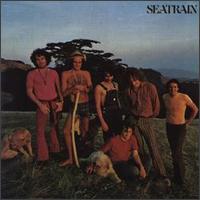 Seatrain
(1970), ***
Seatrain
(1970), ***
And
poof! there went the lineup of Sea Train, replaced by a less
interesting, yet more commercial assemblage of people known as
Seatrain. I guess they figured people would not remember that
they had just had an album that was self-titled, especially with a
slightly changed name. This Seatrain has an entirely
different
feel to it, and although the Kulberg/Roberts songwriting team is
still in place, Kulberg cedes some control to the newcomers.
Roberts is even officially a member of the group - making them one of
the few American bands with an in-house designated lyricist (other
than the Grateful Dead). This new lineup (for those
of you
scoring at home - Larry Atamanuik on drums, Peter Rowan on guitar
and
Lloyd Baskin on keyboards, with Baskin and Rowan splitting lead
vocals) decided to pare down their sound greatly. Oh, not in
terms of the number of group members, but in terms of styles.
Jazz? Almost gone. Kulberg's flute is only let out
once
("Broken Morning"). Classical? Greatly cut down
to some of Baskin's keyboard parts (he sounds like Michael
Brown before an electric harpsichord on "Waiting for
Elijah"). What was left was good old American
roots-rock.
Where Sea Train's focal point constantly shifted, Seatrain
focuses mainly on Greene's violin. This is a good
thing.
Greene was a fiddle player of exceptional talent, and he lets it
shine not only in his spotlight pieces ("Sally Goodin" and
"O.B.S." both of which he arranged and adapted, making them
sound similar to English groups like Fairport Convention) but
throughout the album, frequently with wah-wah pedal attached.
But a paucity of songwriting seems to be on the land. Rowan,
who was the predominant writer for his old group Earth Opera,
contributed three songs - a couple of standard romantic ballads
("Home to You" and "Oh My Love") and a slower
folk song that is nice, gentle and worth the wait ("Waiting for
Elijah"). Roberts' lyrics are not quite as strong;
"Song of Job" is a rather talky retelling of the old
Biblical story, which lacks suspense. Their lone charting
single, "13 Questions," is an odd UFO encounter in reverse,
but with a completely unrelated refrain that happens to be the
catchiest part of the song. Only "Broken Morning"
comes close to his earlier work, but only close. Actually,
Seatrain reworks one of Sea Train's
highlights, "Out
Where the Hills," making it more jaunty and fun before it enters
Greene (solo) land. This version is nowhere close to the
original, but still has the album's most complex arrangement.
The two strongest songs are actually from outside the group --Lowell
George's signature tune and ode to drug-running ("I'm Willing")
before Little Feat recorded it, and an excellent Goffin/King
grandstand ("Creepin' Midnight" where Baskin's vocals just
wallow in soul). This incarnation's playing is much simpler
as
well. Producer George Martin (yes, that George
Martin)
tends to make Baskin the central support in each song, such that one
frequently forgets that Rowan even exists. The entire album
may
not have a guitar solo on it, and often Rowan is completely
inaudible. The band in this incarnation relies more on rhythm
than notes (compare the two "Out Where the Hills"), and the
production is pretty clean, as compared to the intentional overlap of
Sea Train. So the new Seatrain was a
lesser band, a more
focused band, and a decent roots-rock band.
 Seatrain:
Marblehead Messenger (1971), **1/2
Seatrain:
Marblehead Messenger (1971), **1/2
More
of the same, but the songs aren't quite as good. The
Kulberg/Roberts pairing seems to have gone in an odd
direction; Roberts' lyrics are better ("The State of
Georgia's Mind"), but Kulberg's music did not tread any new
ground. This, and the decisions to restrict Greene, simplify
Baskin's parts a bit, and bring Rowan up more, deprivec the band of
any real musical identity (the jaunty folk of "Gramercy"
could be anyone and the anti-war title track, which sounds like a
flop single). Kulberg surprisingly tried to resurrect Sea
Train's classical-hybrid
sound right down to the fuzzy guitar on "London
Song," but note that surprise does not equal great, however, or
especially good. Where surprise does equal good is with
Rowan,
whose writing skills blossomed. He contributed three songs,
two
of which are fun down-home songs ("Protestant Preacher"
with Roberts-like lyrics, the 3/4 ballad "Mississippi Moon").
Baskin wrote one song, "Lonely's Not the Only Way to Go",
which on first listen might sound like a song about being friends,
but upon closer inspection appears to deal with multiple
personalities! Another warning sign is the
resurrection
of Sea Train's "As I Lay Losing," retitled as
"Losing All the Years." This Seatrain gave a
different (inferior) feeling, imbuing it with the warm friendliness
of a 70s roots-rock band, instead of its original colder, dark
reading. Greene has one showcase number ("Despair Tire"),
an odd combination of his hyperspeed bluegrass fiddle interspersed
with Roberts reading intentionally goofy lyrics somewhere between Dr.
Seuss and Shel Silverstein. A strange mixture, and one would
much rather listen to Greene than Roberts continually pun on the
phrase "despair tire." Fans of Seatrain
will
want to check this out, but it is not a good place to start with the
band. Produced by George Martin.
The
Blues Project: Lazarus (1971)
Blumenfeld,
Kolb and Kretmar. Whoopty whoop!
 Blues Project (1972), **
Blues Project (1972), **
Same
people as Lazarus,
but including Flanders, guitarist Bill Lussenden, and
ex-Country Joe and the Fish pianist David Cohen. Produced by
Gabriel Meckler, most famous for producing Steppenwolf and he made the
band even more boring than Steppenwolf ever was. Flanders'
voice was the focus, and Kolb was less sloppy on his leads, but
the band lacked identity, with its mid-tempo, lifeless blues-rock.
The material is a yawn: old covers (think Willie
Dixon) and some Flanders songs. The latter retain some of the
folk sound from his solo album, but he added in a bit more soul to
his voice, although his songs are padded and a bit too grandiose.
Kalb's one song "Crazy Girl" is a bit of departure with
more of a funky backing, but still nothing exciting, and strangely
lacking a strong guitar solo. Unless you want to hear talent
wasted or background music, there is no reason to listen to this.
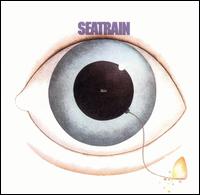 Seatrain:
Watch (1973), **1/2
Seatrain:
Watch (1973), **1/2
A
two-year gap, and a change of labels should have warned fans that
something was afoot. Yes, two of the big names and attention
grabbers are gone - Rowan and Greene - and without these roots-rock
anchors in place the band drifts around from track to track.
But seeing as how their sound had become pretty rote, this is not
necessarily a bad thing. Unfortunately, Seatrain became
susceptible to mid 70s trends, adding in funky passages, Shaft
guitar and the like. It is like using a matchbook -
when
you know what you are doing, the results can be good, but there is a
great potential for self-destruction. Things are good at the
start - the opening track "Pack of Fools" is
Kulberg/Roberts
partnership;s swan song, and new guitarist
Peter Walsh
gets every opportunity to get loose and funky at the end. The
other times Seatrain tries this sort of thing it backfires
completely. It does not help that the two songs that use it
(Kulberg and Roberts' "Freedom Is the Reason" and Baskin's
"We Are Your Children Too") are crappy attempts at 70s
people-affecting anthems. The former is the more palatable of
the two, squatting in a murky rootsy/gospel area and trying to sound
contemplative on "freedom," when all they're doing is
sounding like your average contemporary James
Gang track. I believe that Kulberg is the one
gracing the
song with some weak vocals as well. "We Are Your Children
Too" is much, much worse, affording Baskin the opportunity to
sound like some long-haired "with-it" pastor singing a
contemplative hymn to God, with Kulberg's flute adds a healthy dose
of lameness also. Toss these out, and the band mainly takes
on
a distinctly Louisiana sound, driven by new keyboardist Bill
Elliot.
Baskin's other song, "Bloodshot Eyes" is a fun ragtime romp
with traditional Dixieland backing. The other glimmer of the
Kulberg/Roberts team is "North Coast" which has that
"Mabel" sound - a party going on (you can hear the voices
ask where Richard Greene is, humorously enough), with some of
Elliott's barrel-house piano driving the song. Continuing the
Louisiana theme, "Abbeville Fair" was probably designed to
be a Greene piece, but without him (orchestration helps fill in the
sound) it is just a decent Cajun/folk dance tune. Otherwise,
"Scratch" is yet another anomaly: a simple folk story that
might have come from Twice-Told Tales.
Seatrain
was clearly searching for a new sound without roots-rock gurus Rowan
and Greene, but they never really found it on Watch.
The
songwriting appears to have dried up somewhat, precipitating a decent
bluesy take on Dylan's "Watching the River Flow." It
may also be why the album's end is occupied up by a long version of
Kulberg's old Blues Project spotlight number "Flute Thing."
He may have considered it his trump card, but I doubt many listeners
allowed it to be played. It might have been interesting to
hear
them pursue the Cajun or ragtime theme, but their breakup isn't
unexpected given this album.
The
Blues Project: Reunion in Central Park (1973)
The
original lineup, I understand. A one-time event.
Wake
me, shake me back to the Music Page...
 The
Blues Project: Live at the Cafe A Go Go (1966), **1/2
The
Blues Project: Live at the Cafe A Go Go (1966), **1/2
 The
Blues Project: Projections (1966), ***
The
Blues Project: Projections (1966), *** Blues
Project at the Town Hall (1967), ***
Blues
Project at the Town Hall (1967), *** Blues
Project: Planned Obsolescence (1968), ***1/2
Blues
Project: Planned Obsolescence (1968), ***1/2 Tommy Flanders:
Tommy Flanders:  Sea
Train (1969), ****1/2
Sea
Train (1969), ****1/2 Seatrain
(1970), ***
Seatrain
(1970), *** Seatrain:
Marblehead Messenger (1971), **1/2
Seatrain:
Marblehead Messenger (1971), **1/2 Blues Project (1972),
Blues Project (1972),  Seatrain:
Watch (1973), **1/2
Seatrain:
Watch (1973), **1/2